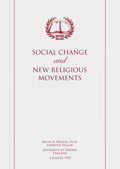When, after the Reformation, divergent forms of Christian belief acquired a body of stable adherents, and emerged as new religious movements, they almost always encountered extreme intolerance. The Hutterites, initially originating in the Tyrol, were recurrently put to the sword, and forced in stages to flee from one settlement to another across central Europe. The Quakers in England suffered persistent harassment in the late 17th century, and many of them were imprisoned for their beliefs. The early Methodists in the 18th century were frequently mobbed and some of their chapels burned. Local law officers and magistrates were not infrequently party to such persecution, stimulating mob action, and regarding these law—abiding religionists as culprits rather than as victims. In late 19th century England, the early adherents of the Salvation Army suffered similar hostility. In one year alone over 600 of its “soldiers” were assaulted by “roughs” whom Salvationists believed were encouraged by the influential brewing industry. On the other hand, in the course of a few years a similar number of Salvation Army personnel were imprisoned on such dubious and perhaps trumped—up charges as obstructing the highway. In Switzerland in the 1890s they were indicted for deception and financial exploitation, charges similar to those which had been brought against Mormon missionaries in Scandinavia earlier in the century.
Early in the 20th century opposition to some new religions was expressed in different forms: Christian Science was bitterly denounced both for its claims to spiritual healing and its denial of the reality of matter, but the condemnation was largely literary, ranging from the satire of Mark Twain to the serious onslaught of the distinguished historian, H.A.L. Fisher, among a veritable library of hostile commentaries from clergymen, medical practitioners, and, in lighter vein, a genre of lampoons, cartoons, and satirical novels. Opposition to Jehovah’s Witnesses, still seen as a new movement in the first half of the 20th century, was often more physically expressed. They suffered crowd violence in the United States in the Second World War, and some were tarred and feathered. They were persecuted for refusing to salute the flag and to sing the national anthem not only in the United States but in countries as different as Malawi, and their conscientious objection to military service brought them legal prosecution in France, Spain and Greece even in recent decades. In Quebec, this generally law‑abiding sect was relentlessly pursued by government law officers throughout the 1940s and 50s on a wide variety of supposed infringements of the law. The examples could be multiplied‑they serve to illustrate the continuing incidence of religious intolerance and the recurrent opposition to newly emerging religious organizations and new conceptions of religious practice.
What all of these instances have in common is that these victimized sects were all, in their day, relatively new minority religious movements. Because they deigned to dissent from one or another prescription of the established religion, or chose to entertain their own conceptions of deity, salvation and worship, or because they challenged the norms of contemporary secular society, they became objects of distrust, and were regarded as agents of social disruption.





























